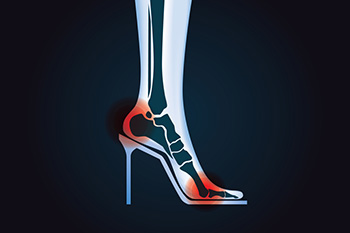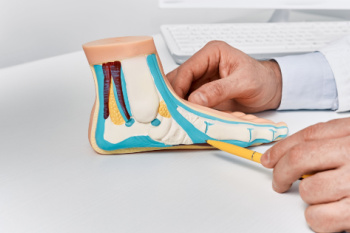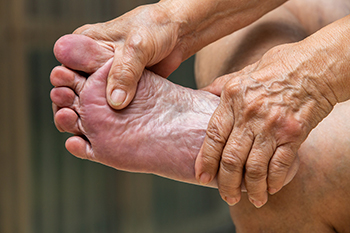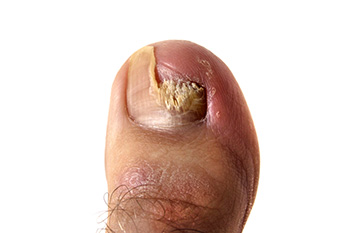Middlefield (860) 349-8500
Wallingford (203) 294-4977
Middlefield (860) 349-8500
Wallingford (203) 294-4977

Wearing high heels can lead to a variety of foot problems due to the unnatural positioning and pressure they place on the feet. High heels force the toes into a confined space and push the body’s weight forward, increasing pressure on the toes and the ball of the foot. This can lead to painful conditions such as bunions, corns, and calluses. Over time, wearing high heels can also cause shortening and tightening of the Achilles tendon, leading to Achilles tendinitis or heel pain. Additionally, the elevated heel alters the natural alignment of the spine and joints, potentially causing back and knee pain. High heels can also contribute to the development of plantar fasciitis due to the strain they place on the bottom of the foot. While wearing high heels occasionally may not cause immediate harm, frequent use can lead to long-term foot and joint problems. If you have foot pain from wearing high heels, it is suggested that you confer with a podiatrist who can treat various foot conditions, and educate you on more appropriate shoes to wear.
High heels have a history of causing foot and ankle problems. If you have any concerns about your feet or ankles, contact Dr. Gordon Fosdick from Affiliated Foot Care Center. Our doctor can provide the care you need to keep you pain-free and on your feet.
Effects of High Heels on the Feet
High heels are popular shoes among women because of their many styles and societal appeal. Despite this, high heels can still cause many health problems if worn too frequently.
Which Parts of My Body Will Be Affected by High Heels?
What Kinds of Foot Problems Can Develop from Wearing High Heels?
How Can I Still Wear High Heels and Maintain Foot Health?
If you want to wear high heeled shoes, make sure that you are not wearing them every day, as this will help prevent long term physical problems. Try wearing thicker heels as opposed to stilettos to distribute weight more evenly across the feet. Always make sure you are wearing the proper shoes for the right occasion, such as sneakers for exercising. If you walk to work, try carrying your heels with you and changing into them once you arrive at work. Adding inserts to your heels can help cushion your feet and absorb shock. Full foot inserts or metatarsal pads are available.
If you have any questions please feel free to contact our offices located in Middlefield and Wallingford, CT . We offer the newest diagnostic and treatment technologies for all your foot and ankle needs.

Flat feet, or fallen arches, occur when the arches of the feet flatten causing the entire sole to make contact with the ground. While some people experience no symptoms, others may suffer from foot pain, swelling, or discomfort, especially after standing or walking for long periods. Flat feet can be congenital, develop over time due to aging, injury, or arthritis, or may result from weakened tendons. Treatment becomes necessary if flat feet cause persistent pain, affect mobility, or lead to other complications like knee or back issues. Non-surgical options include wearing supportive footwear, custom orthotics, and targeted stretching exercises. In severe cases, surgical intervention may be required to correct structural damage. If flat feet are interfering with your daily life, it is suggested that you visit a podiatrist for a proper assessment and personalized treatment plan.
Flatfoot is a condition many people suffer from. If you have flat feet, contact Dr. Gordon Fosdick from Affiliated Foot Care Center. Our doctor will treat your foot and ankle needs.
What Are Flat Feet?
Flatfoot is a condition in which the arch of the foot is depressed and the sole of the foot is almost completely in contact with the ground. About 20-30% of the population generally has flat feet because their arches never formed during growth.
Conditions & Problems:
Having flat feet makes it difficult to run or walk because of the stress placed on the ankles.
Alignment – The general alignment of your legs can be disrupted, because the ankles move inward which can cause major discomfort.
Knees – If you have complications with your knees, flat feet can be a contributor to arthritis in that area.
Symptoms
Treatment
If you are experiencing pain and stress on the foot you may weaken the posterior tibial tendon, which runs around the inside of the ankle.
If you have any questions please feel free to contact our offices located in Middlefield and Wallingford, CT . We offer the newest diagnostic and treatment technologies for all your foot and ankle needs.

As people age, foot health becomes increasingly important, as the feet undergo changes that can lead to various problems. Older feet require extra care due to factors such as reduced circulation, decreased skin elasticity, and the natural wear and tear on bones and joints. Seniors often experience foot conditions like arthritis, which causes pain and stiffness in the joints, as well as bunions, a deformity that develops at the base of the big toe. Additionally, poor circulation can lead to conditions like swelling or cold feet, while thinning skin increases the risk of cuts and infections. Many older adults also develop toe problems like hammertoes, corns, and calluses. Proper footwear, regular foot inspections, and professional foot care are essential in preventing these issues from worsening and maintaining mobility and overall foot health. If you are a senior, it is suggested that you schedule regular visits with a podiatrist who can effectively monitor your foot health.
Proper foot care is something many older adults forget to consider. If you have any concerns about your feet and ankles, contact Dr. Gordon Fosdick from Affiliated Foot Care Center. Our doctor can provide the care you need to keep you pain-free and on your feet.
The Elderly and Their Feet
As we age we start to notice many changes in our body, but the elder population may not notice them right away. Medical conditions may prevent the elderly to take notice of their foot health right away. Poor vision is a lead contributor to not taking action for the elderly.
Common Conditions
Susceptible Infections
Diabetes and poor circulation can cause general loss of sensitivity over the years, turning a simple cut into a serious issue.
If you have any questions please feel free to contact our offices located in Middlefield and Wallingford, CT . We offer the newest diagnostic and treatment technologies for all your foot and ankle needs.

Thick toenails, medically known as onychomycosis, is a fungal infection where the toenails become discolored, thickened, and brittle. The nails may appear yellow, white, or even brown, and can sometimes separate from the nail bed. This infection typically occurs after exposure to fungi that thrive in warm, damp environments, such as sweaty shoes or communal areas like swimming pools. Poor foot hygiene, a weakened immune system, or diabetes can also increase the risk of developing onychomycosis. Symptoms include thickened, misshapen nails, crumbling edges, and a foul odor. If left untreated, the infection can worsen, leading to pain and difficulty walking. A podiatrist is trained to diagnose and treat nail fungus effectively. Treatments may include antifungal medications, topical solutions, laser therapy, or in severe cases, nail removal. Your podiatrist will assess the severity of the infection and recommend the best course of treatment. If you are dealing with this issue, it is suggested that you schedule an appointment with a podiatrist.
For more information about treatment, contact Dr. Gordon Fosdick of Affiliated Foot Care Center. Our doctor can provide the care you need to keep you pain-free and on your feet.
Toenail Fungus Treatment
Toenail fungus is a condition that affects many people and can be especially hard to get rid of. Fortunately, there are several methods to go about treating and avoiding it.
Antifungals & Deterrence
Oral antifungal medicine has been shown to be effective in many cases. It is important to consult with a podiatrist to determine the proper regiment for you, or potentially explore other options.
Applying foot powder on the feet and shoes helps keep the feet free of moisture and sweat.
Sandals or open toed shoes – Wearing these will allow air movement and help keep feet dry. They also expose your feet to light, which fungus cannot tolerate. Socks with moisture wicking material also help as well.
If you have any questions please feel free to contact our offices located in Middlefield and Wallingford, CT . We offer the newest diagnostic tools and technology to treat your foot and ankle needs.